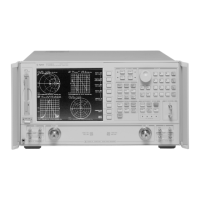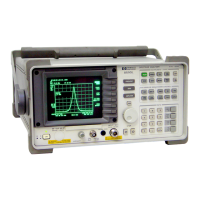8-18
Preset State and Memory Allocation
Memory Allocation
If correction is on at the time of an external store, the calibration set is stored to disk.
(Note that inactive calibrations are not stored to disk.) When an instrument state is loaded
into the analyzer from disk, the stimulus and response parameters are restored first. If
correction is on for the loaded state, the analyzer will load a calibration set from disk that
carries the same title as the one stored for the instrument state.
Conserving Memory
If you are concerned about conserving memory, either internal memory or external disk
space, some of the most memory-intensive operations include:
• two-port error correction
• interpolated error correction
• 1601 measurement points
• using time domain
• saving data arrays and graphics with the instrument state
Using Saved Calibration Sets
When you are saving to internal memory (CMOS, non-volatile memory), calibration sets
are linked to the instrument state and measurement parameter for which the calibration
was done. Therefore a saved calibration can be used for multiple instrument states as long
as the measurement parameter, frequency range, and number of points are the same. A
full 2-port calibration is valid for any S-parameter measurement with the same frequency
range and number of points. When an instrument state is deleted from memory, the
associated calibration set is also deleted if it is unused by any other state.
The following hints will help you avoid potential problems:
• If a measurement is saved with calibration and interpolated calibration on, it will be
restored with interpolated calibration on.
• A calibration stored from one instrument and recalled by a different one will be invalid.
To ensure maximum accuracy, always recalibrate in these circumstances.
• No record is kept in memory of the temperature when a calibration set was stored.
Instrument characteristics change as a function of temperature, and a calibration
stored at one temperature may be inaccurate if recalled and used at a different
temperature. Refer to Chapter 2 , “8753ET Specifications and Characteristics,” for
allowable temperature ranges for individual specifications.
• The analyzer can read disk files created by the 8753B/C/D and the 8753B/C/D can read
files created by the 8753E. Note, however, that only those cal sets supported by the
8753B/C/D can be read by an 8753B/C/D from a disk created by an 8753E. A disk file
translator is available to make 8753A disk files compatible with 8753B files. These files
can then be read by the 8753E. Contact your local Agilent Technologies sales and
service office for a copy of this disk file translator.

